11 Weeds With Orange Flowers: Identification And Control Tips (Photos)
When it comes to weeding your garden, it can be overwhelming to deal with so many unwanted plants. However, if you know what to look for and how to get rid of them, the task becomes much more manageable. In this article, we’ll focus on a specific type of weed that is characterized by its bright orange flowers: the weed with orange flowers. You’ll learn not only how to identify it but also how to control it.
The weeds we’ll cover in this post are:* Butterfly Weed (Asclepias tuberosa): This weed has distinctive orange or yellow flowers and grows in well-drained soil.* Chinese Lantern (Abutilon pictum): Known for its bright orange lantern-shaped flowers, this weed thrives in warm climates.* Dalmatian Toadflax (Linaria dalmatica): With its small, delicate flowers and distinctive leaves, this weed is a common sight in many gardens.
* Evening Primrose (Oenothera versicolor): This weed has showy, orange-yellow flowers that bloom in the evening and are often found growing in disturbed areas.* Orange Hawkweed (Hieracium aurantiacum): This daisy-like weed has bright orange petals and is known for its ability to spread quickly.* Orange Jewelweed (Impatiens capensis): With its vibrant orange flowers and distinctive seed pods, this weed can be a bit of a nuisance in gardens.
* Orange Nasturtium (Tropaeolum): This weed has delicate, crepe-paper-like flowers and is often found growing in moist areas.* Red Chickweed (Anagallis arvensis): While its red flowers might seem attractive at first glance, this weed can be quite invasive.* Red Sorrel (Rumex acetosella): With its bright green leaves and reddish stems, this weed is a common sight in many gardens.
* Tawny Day-Lily (Hemerocallis fulva): This ornamental lily has bright orange flowers and can spread quickly if not kept under control.* Trumpet Creeper (Campsis radicans): With its showy, trumpet-shaped flowers and aggressive growth habit, this weed can be a bit of a challenge to deal with. In this article, we’ll explore the characteristics of each of these weeds, as well as provide tips on how to identify and get rid of them.
Butterfly Weed (Asclepias tuberosa)
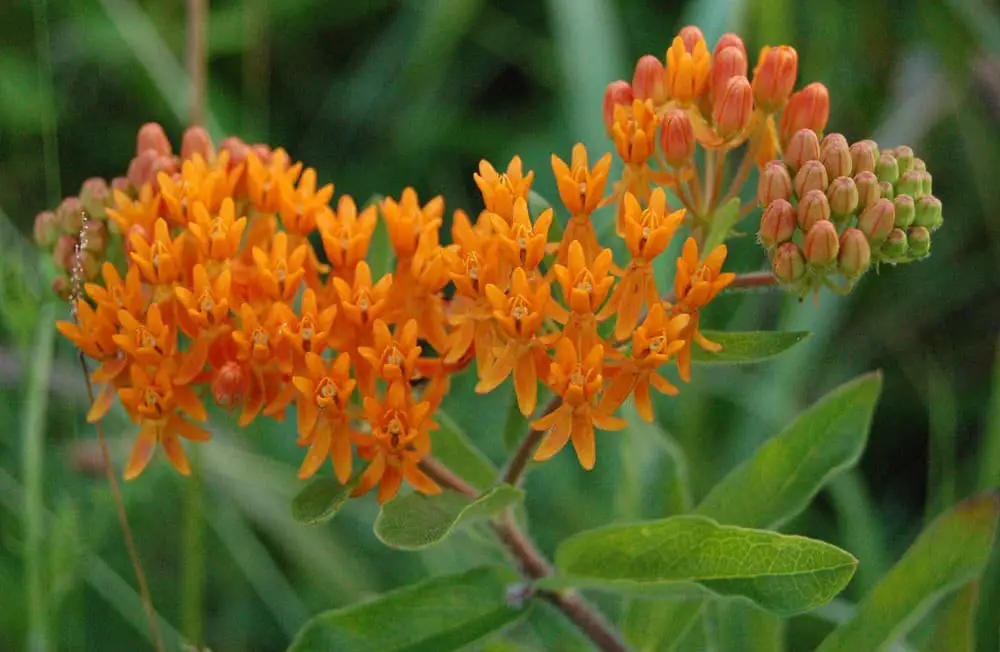
What is butterfly weed?
The vibrant orange butterfly weed flower is a stunning sight to behold during the summer months. Its striking coloration is not only aesthetically pleasing, but also plays a crucial role in attracting a specific type of insect – the butterfly. In fact, this flowering plant has earned its name due to its status as a beloved nectar source for these delicate creatures.
Where does butterfly weed grow?
Native to the eastern and central regions of the United States, butterfly weed thrives in environments characterized by full sunlight and arid soil conditions.
What does butterfly weed look like?
Characterized by its slender foliage and vibrant blooms, butterfly weed boasts a distinctive appearance. Its leaves stretch out in a narrow, elongated shape, providing a striking contrast to the bright orange flowers that burst forth in clusters. Each bloom is comprised of five petals, measuring approximately an inch in width.
How do you plant butterfly weed?
When it comes to planting butterfly weed, start by digging a hole that’s approximately twice the width of the root ball. Make sure the hole is just as deep as well. Next, gently place the plant into the hole, taking care not to disturb its roots. Once settled, backfill with soil, ensuring the soil level matches where it was originally situated in the root ball. Finally, give the soil a good soaking to help settle any compacted soil and provide enough moisture for establishment.
When does butterfly weed bloom?
Butterfly weed, with its vibrant blooms occurring from June to August, is a prized addition to any garden. Before you begin planting this perennial beauty, it’s essential to understand its characteristics and requirements. A notable feature of butterfly weed is its ability to thrive in dry conditions, making it an excellent choice for water-conscious gardeners. Additionally, as a perennial plant, it will return year after year, providing a lasting display of color and charm.
How to get rid of butterfly weed:
To eliminate butterfly weed, consider the most effective approach: uprooting the plant. This might be a challenging task due to its deep and robust roots. Nevertheless, with persistence, you should be able to eradicate all of it. For those who prefer an alternative solution, herbicides can be used as a last resort, but this method carries risks for other flora and fauna in the vicinity. If opting for herbicide, meticulously adhere to the product’s label instructions.
Chinese Lantern (Abutilon pictum)

What is Chinese lantern?
The Chinese lantern (Abutilon pictum) is a perennial herb that belongs to the nightshade family, native to China and India where it’s also known as Asiatic or Indian nightshade. This striking plant can grow up to two feet tall, boasting small white flowers and vibrant orange-red fruits adorned with a papery covering. While its beauty is undeniable, caution should be exercised around Chinese lantern, as all parts of the plant are toxic when ingested by humans and animals.
Despite this toxicity, the plant has been used in traditional Chinese medicine for centuries to treat various ailments. The fruit is employed to alleviate digestive issues such as diarrhea and constipation, while the leaves have been used to soothe skin conditions like eczema and psoriasis.
What does Chinese lantern look like?
The Chinese lantern, also known as the Japanese lantern or winter cherry, is a fascinating plant native to Asia. Its distinctive features include long, slender leaves and small, rounded fruits that burst forth orange or red hues when ripe. Each fruit contains numerous seeds, which are dispersed into the environment once they mature. The Solanaceae family, to which it belongs, comprises other well-known plants such as tomatoes, potatoes, and eggplants.
Interestingly, this annual plant thrives in warm climates with ample sunlight, completing its life cycle within a single year.
How to get rid of Chinese lantern:
When you spot the invasive plant, take swift action by cutting it down to ground level. This will halt its ability to produce seeds and spread further. Next, excavate the root system and properly dispose of it. If you have a compost pile, ensure the roots are buried at a sufficient depth to prevent regrowth. As an alternative method, consider using an herbicide, but always adhere to the product’s instructions and safety guidelines.
Dalmatian Toadflax (Linaria dalmatica)
What is dalmatian toadflax?
Dalmatian toadflax is an herbaceous perennial that has made itself at home across the globe, having naturalized in parts of Europe, Asia, Africa, and North America. Its Mediterranean roots are evident in its ability to thrive in various environments, from roadsides to meadows, open woodlands, pastures, and even crowding out native flora with its rapid spread. This invasive species bears a striking resemblance to the common toadflax (Linaria vulgaris), earning it its namesake.
What does dalmatian toadflax look like?
Dalmatian toadflax, a perennial herb that can reach heights of up to two feet, boasts a striking appearance featuring pale yellow flowers adorned with distinctive orange spots and long, linear leaves. Native to Europe and Asia, this plant has been unintentionally introduced to North America, where it is now regarded as an invasive species due to its ability to outcompete native vegetation for resources.
How to get rid of dalmatian toadflax:
To eradicate dalmatian toadflax, a straightforward yet often challenging approach is to manually extract the entire plant, including its deep taproot. However, this method may not always yield desired results, especially if the root system has become deeply embedded in the surrounding soil. In such cases, attempting to cut the plant down at ground level can be an effective alternative.
When handling this plant, it is essential to take necessary precautions to protect your skin from potential irritation caused by the sap. This includes wearing appropriate personal protective equipment, such as gloves and long sleeves. Additionally, for a more targeted approach, consider using herbicides in accordance with product instructions to control the spread of dalmatian toadflax.
Evening Primrose (Oenothera versicolor)
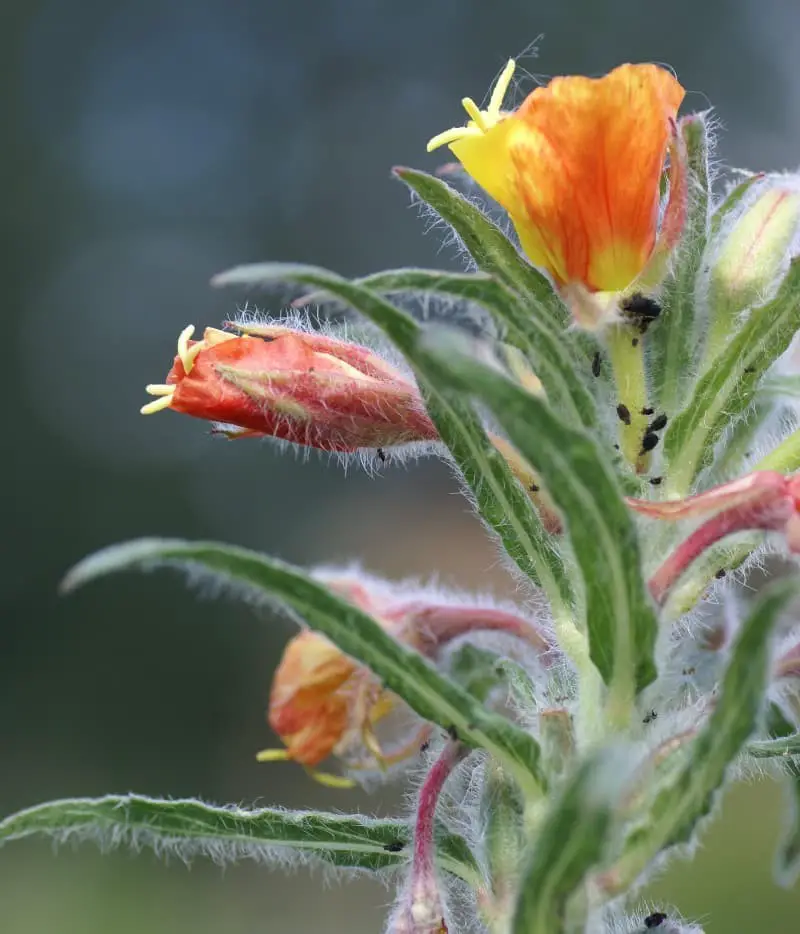
What is evening primrose?
Evening primrose, Oenothera versicolor, is a North American native that unfolds its beauty in the evening hours. This striking flora reaches a height of around two feet, boasting yellow blooms measuring approximately four inches wide. The delicate petals release a sweet fragrance, filling the air with a subtle charm. A fleeting delight, the flowers only bloom for one magical night, their short-lived splendor giving way to the development of seed capsules as the petals fall away.
What does evening primrose look like?
Evening primrose, a perennial wildflower, boasts an impressive height of up to four feet. Characterized by its oblong and lanceolate leaves, this plant’s bright yellow flowers emerge in clusters. The fruits that follow are small, hard capsules packed with black seeds.
How to get rid of evening primrose:
To eradicate evening primrose from your garden or yard, it’s essential to remove the entire plant, including its roots. If you’re dealing with a widespread infestation, consider employing a targeted herbicide like glyphosate, which has been shown to be effective in eliminating this pesky weed. However, when using any herbicide, always adhere strictly to the product’s instructions and take necessary precautions to avoid harm to people, pets, or the environment.
Orange Hawkweed (Hieracium aurantiacum)
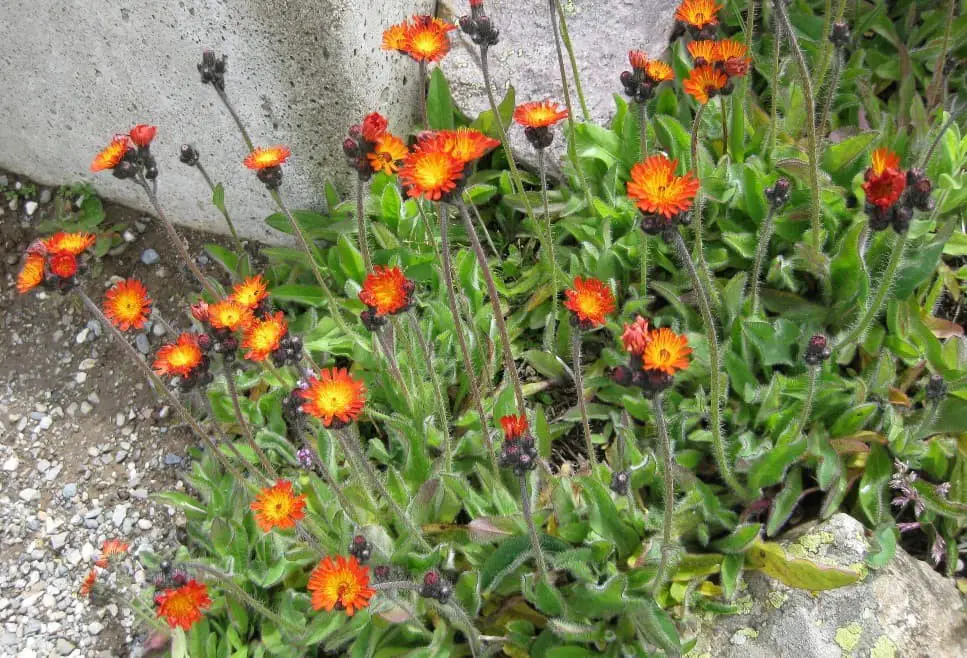
What is orange hawkweed?
Orange hawkweed (Hieracium aurantiacum) is a perennial herb that belongs to the sunflower family. Reaching heights of up to 30 cm, this plant boasts vibrant orange or yellow flowers that adorn its stems. Native to Europe and Asia, it has been introduced to North America, where it is deemed an invasive species. Orange hawkweed’s insidious nature causes problems in both agricultural and natural environments.
In agricultural settings, it vies for water and nutrients with crops, while in natural areas, it can supplant native flora, resulting in reduced biodiversity.
What does orange hawkweed look like?
Orange hawkweed is a perennial herb that boasts a moderate growth habit, reaching heights between 30-60 cm (12-24 inches) tall. Its leaves are characterized by a lanceolate to oblong-lanceolate shape, while the flowers are clustered in groups of 15-30. The flower heads themselves display vibrant orange or yellow hues, with each head consisting of approximately 15 individual florets.
How to get rid of orange hawkweed:
Orange hawkweed can be a persistent nuisance in lawns and gardens, demanding attention to eradicate it completely. While removal is possible, it necessitates some diligence. To effectively banish this pesky weed, consider the following strategies:
Firstly, attempt to remove it by pulling up the roots. Although time-consuming, this method can be effective if done correctly. However, be prepared for the possibility of missing some residual roots.
Alternatively, utilize a herbicide specifically designed to target orange hawkweed. It’s crucial to carefully read and follow the product’s instructions to ensure successful eradication.
If a more gentle approach is desired, consider mowing the area before the plant has a chance to flower and produce seeds. While this won’t kill the weed outright, it will hinder its spread and provide an opportunity for further removal attempts.
Orange Jewelweed (Impatiens capensis)

What is orange jewelweed?
In North America, a vibrant orange-flowered plant called Orange jewelweed or touch-me-not catches the eye. Its unique characteristic is the sudden explosive release of its seed pods when touched, earning it the name. This intriguing behavior has led to the plant’s common appellation.
Beyond its fascinating reproductive method, Orange jewelweed also holds medicinal significance. Some proponents swear by its ability to alleviate symptoms associated with poison ivy and other skin irritations.
Furthermore, its natural insect-repelling properties have made it a popular choice for those seeking a chemical-free deterrent.
What does orange jewelweed look like?
Standing at an impressive height of up to two feet, orange jewelweed boasts a striking appearance with its green leaves and vibrant orange flowers. This charming plant thrives during the summer months, blooming from June to September. Its preferred habitats include moist woodlands and scenic streamside environments.
How to get rid of orange jewelweed:
When dealing with unwanted orange jewelweed in your garden, a few strategies can help eliminate it. One approach is to physically remove it by pulling it out by its roots. If this method isn’t effective, you may need to get a little more aggressive and use a hoe or trowel to carefully dig up the entire plant. As a last resort, herbicides can be used, but it’s crucial to follow the product instructions to avoid any potential harm to your garden or surrounding environment.
Orange Nasturtium (Tropaeolum)
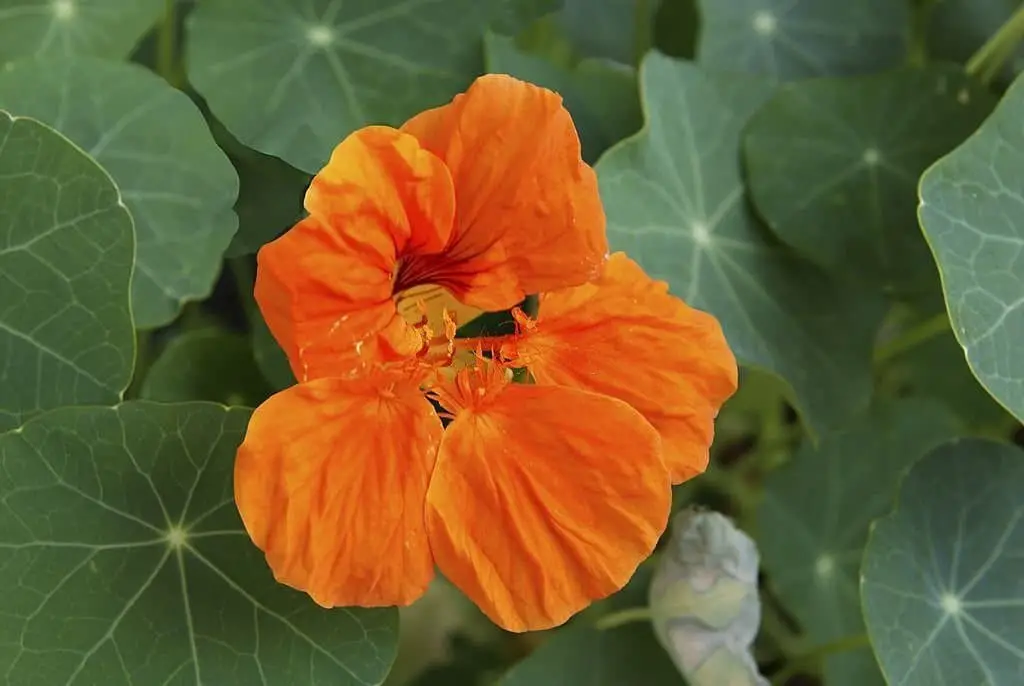
What is orange nasturtium?
The Tropaeolaceae family, home to the vibrant orange nasturtium (Tropaeolum), boasts a native species from Peru in South America. As a herbaceous perennial, this stunning plant reaches heights of up to 30 cm, boasting bright orange blooms and rounded green leaves. Its ornamental value makes it a popular choice for gardens and parks.
One of the most appealing aspects of the orange nasturtium is its low-maintenance requirements.
Propagation via seeds or cuttings is straightforward, and the plant thrives in conditions that include full sun and well-drained soil. Surprisingly, it also proves tolerant of poor soils. Additionally, this resilient plant boasts natural resistance to pests and diseases, making it an excellent addition to any garden.
What does orange nasturtium look like?
The visually striking orange nasturtium boasts an unmistakable appearance, characterized by its large, rounded leaves and vibrant orange blooms. The slender stems of this plant can stretch considerable heights as it grows. While its aesthetic appeal is undeniable, what’s more remarkable is the ease with which it adapts to care. With minimal effort, you can coax this lovely flora into a thriving state.
How to get rid of orange nasturtium:
To effectively eradicate orange nasturtium, it’s essential to target its root system. This can be achieved through manual removal of the plant or by utilizing a herbicide. When opting for the latter approach, it’s crucial to thoroughly read and adhere to the product instructions to ensure accurate application.
Red Chickweed (Anagallis arvensis)
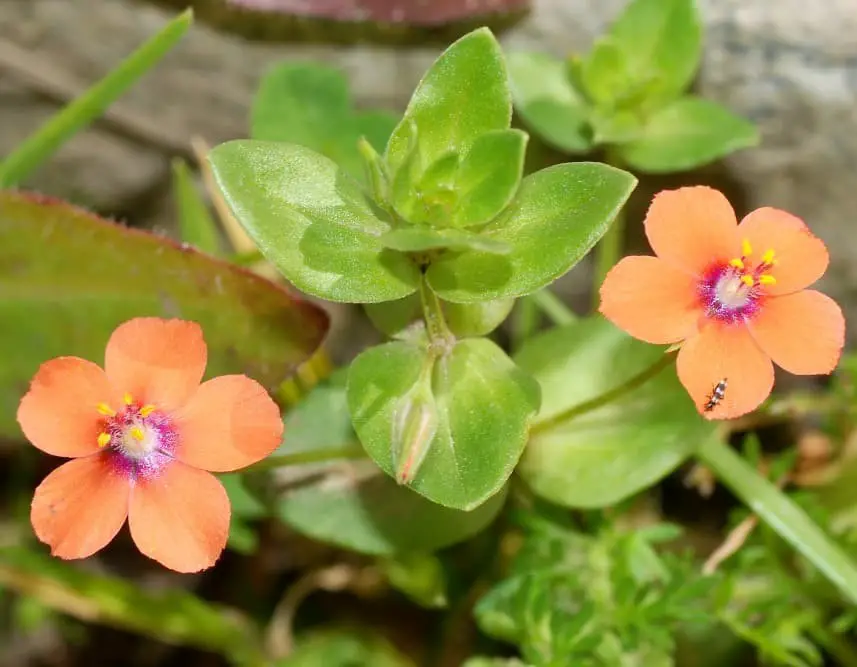
What is red chickweed?
Red chickweed, a member of the Primulaceae family, thrives in neglected environments across North America. This hardy perennial can be found growing wild in abandoned lots, disturbed ecosystems, and along highway medians. In colder climates, chickweed is an annual plant that often sprouts as an unwelcome visitor in home gardens. Its diminutive, crimson blooms are typically solitary or paired on slender stems.
How can you identify red chickweed?
Red chickweed is characterized by its diminutive, crimson blooms and paired, elliptical leaves that alternate along the stem. The stems themselves are frequently tinged with red and covered in fine hairs. This plant typically reaches a modest height of around 15 centimeters (approximately six inches).
What are the benefits of red chickweed?
Red chickweed has been a staple in traditional medicine for centuries, with its leaves and stems utilized to craft teas and tinctures that offer relief from a range of afflictions. Coughs, colds, stomachaches, and diarrhea are just a few examples of the ailments that red chickweed is believed to help alleviate. Additionally, this plant has been touted as a natural diuretic and expectorant, making it a valuable asset in the treatment of various respiratory issues.
Furthermore, the young leaves of the red chickweed can be consumed raw or cooked, allowing for its use not only as a medicinal resource but also as a potential food source.
How to get rid of red chickweed:
Red chickweed’s invasive nature makes it a challenging weed to manage, as it rapidly spreads and generates copious amounts of seeds. Eradicating this pesky plant requires a combination of regular uprooting and flower removal before seed production can occur. Additionally, targeting the roots with a herbicide may be necessary to ensure complete elimination.
Red Sorrel (Rumex acetosella)
What is red sorrel?
The culinary and medicinal applications of red sorrel’s leaves are just as impressive as its native range, spanning Europe, Asia, and North Africa. When consumed raw or cooked, the slightly tart leaves add a burst of flavor to salads or dishes. Notably, they’re also an excellent source of vitamin C. However, it’s essential to note that large quantities can contain oxalic acid, which may have adverse effects.
Nevertheless, when used in moderation, red sorrel’s leaves offer a unique and nutritious addition to any meal.
What does red sorrel look like?
A diminutive yet fascinating specimen, red sorrel stands at a height of approximately 30 centimeters. Its leafy appendages take on an oblong-lanceolate shape, while the delicate flowers emit a soft greenish-white hue. Native to Europe, Asia, and North America, this unassuming herbaceous plant can be found flourishing in various regions.
How to get rid of red sorrel:
To effectively eradicate red sorrel, consider a multi-faceted approach. For small patches, simply pull up the plants by their roots. However, if you’re dealing with a widespread infestation, a herbicide may be necessary. When using chemical controls, it’s crucial to adhere strictly to the product’s instructions and take necessary safety precautions. Alternatively, you can try suffocating the red sorrel by applying a thick layer of mulch around your desired plants.
This method is particularly effective in suppressing weed growth over time. If you’re looking for a more sustainable solution, consider introducing a ground cover that will outcompete the red sorrel. Some suitable options include white clover, black-eyed susans, and periwinkle. These low-maintenance alternatives can help to crowd out the unwanted vegetation and create a more balanced ecosystem.
Tawny Day-Lily (Hemerocallis fulva)
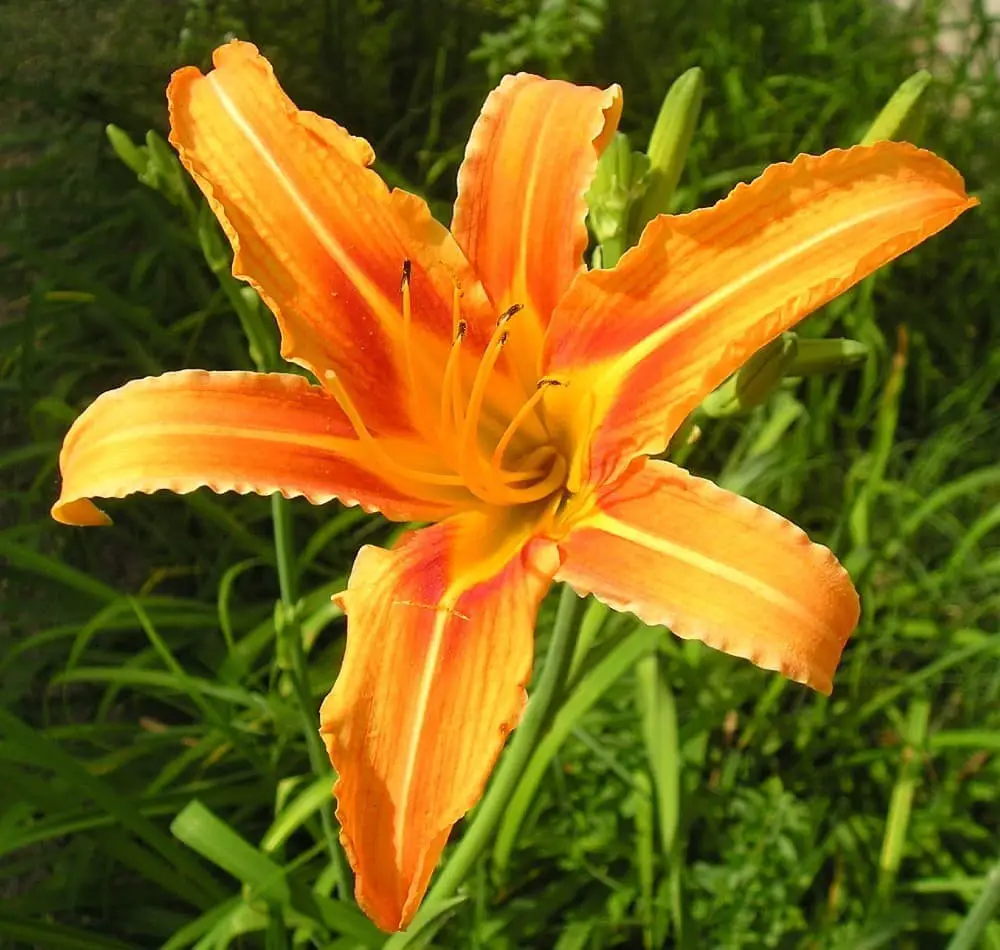
What is tawny day-lily?
The tawny day-lily (Hemerocallis fulva) is a perennial plant native to Asia, specifically China and Japan, where it’s also known as the orange day-lily, tiger lily, or ditch lily. Its introduction to North America and Europe has made it a common sight in many parts of the world. Characterized by its vibrant orange or yellow blooms, the tawny day-lily is a unique species that only produces flowers for one day each summer season.
Interestingly, despite its common name ‘day-lily’, this plant is not related to true lilies (Lilium spp.), making it an intriguing addition to any botanical collection.
What does tawny day-lily look like?
Characterized by its striking appearance, the Tawny Day-Lily boasts long, strap-like leaves and vibrant tawny-orange flowers. A fleeting beauty, each bloom has a short lifespan of just one day, earning it its common name. As a perennial plant, the Tawny Day-Lily is designed to return year after year, requiring minimal upkeep. Its adaptability also makes it a versatile addition to any garden, thriving in a range of soil types with ease.
How to get rid of tawny day-lily:
To eradicate tawny day-lily from your garden, a physical approach is often the most effective method. This involves digging up the plant, including its root system, and disposing of all parts to prevent regrowth. If manual removal isn’t feasible or desirable, smothering can be an alternative solution. Cover the plant with a thick layer of mulch or plastic sheeting, blocking out light and disrupting photosynthesis.
However, chemical control is generally not recommended due to the plant’s inherent resistance to most herbicides. Should you choose to use chemicals, it’s crucial to adhere strictly to product label instructions.
Trumpet Creeper (Campsis radicans)
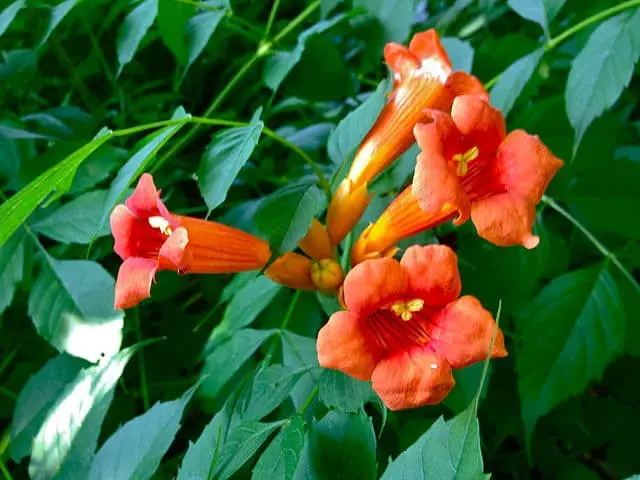
What is trumpet creeper?
Trumpet creeper, a deciduous vine, boasts an impressive growth rate, reaching lengths of up to 30 feet. Its showy trumpet-shaped flowers, typically bearing hues of red, orange, or yellow, bloom from June to September, adding vibrant color and interest to any landscape. Native to the eastern United States, this adaptable vine can thrive in various regions across the country. For gardeners seeking a low-maintenance yet visually striking addition, Trumpet creeper is an excellent choice.
With its tolerance for most soil types, partial shade, and even drought conditions once established, this versatile plant requires minimal upkeep, making it perfect for busy green thumbs.
What does trumpet creeper look like?
The Trumpet Creeper, a stunning vine capable of reaching lengths of up to 30 feet, is characterized by its vibrant, trumpet-shaped flowers that typically display a palette of red, orange, or yellow hues. Its dark green and glossy leaves provide a striking contrast to the bright blooms, which flourish from June to August, painting the surrounding environment with a kaleidoscope of color.
How to get rid of trumpet creeper:
When dealing with trumpet creeper on your property, you have three primary options: excavation, pruning, or herbicide application. If you choose to remove it by digging, be thorough in uprooting the entire plant, as its deep taproots can make complete removal challenging. Alternatively, cutting the creeper down will require repeated efforts, as it will regrow from the remaining roots.
Herbicides offer the most effective solution, but ensure you follow instructions carefully to avoid any potential drawbacks.
Related Posts
When it comes to lawn care, tipping the workers who tend to your grass can be a point of confusion. In this digital age, with our increasing reliance on automation and technology, the traditional concept of tipping may seem outdated. However, the importance of showing appreciation for hardworking individuals remains unchanged.
In this context, understanding gratuity etiquette is crucial, especially when it comes to lawn service workers who dedicate their time and effort to maintaining your property’s lush appearance.






